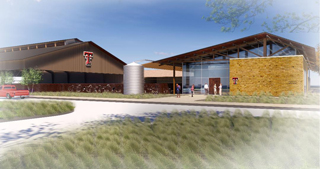
Texas Tech 320

Image courtesy of Texas Tech University
An artist's rendering depicts large animal facilities for the planned Texas Tech University School of Veterinary Medicine. The program is to occupy 250,000 square feet of space, including buildings, barns and open areas in and around Amarillo, the largest city in the Panhandle.
With nearly $17.4 million promised in state support, Dr. Guy Loneragan says Texas Tech University is one step closer to hiring faculty for its budding School of Veterinary Medicine.
The state funding is "everything we asked for," he said.
Loneragan, a veterinary epidemiologist and professor, recently was appointed dean of the Tech school, which received the allocation as a line item in the state's biennial budget bill.
As part of the $250.7 billion spending plan, lawmakers set aside $7,500,000 in 2020 and $9,850,000 in 2021 to develop the Tech veterinary school. Passed on May 26, the measure awaits Gov. Greg Abbott's signature.
While Abbott has the power to veto the budget in full or in part, his approval is widely anticipated. Tech's four-year veterinary program would be the second in Texas and the 31st in the country (assuming it opens ahead of programs proposed at the University of Arizona and Long Island University).
Plans to admit 40 to 50 students to the program's inaugural class in fall 2021 are on schedule, Loneragan said. The program already has fundraised $90 million from the city of Amarillo and other donors for construction, piggybacking on $4.2 million the state appropriated for Tech in 2017. Pending approval by the Texas Tech University System Board of Regents, groundbreaking likely will begin later this year. The program will not include a traditional teaching hospital. Instead, students will rotate through Texas Panhandle practices, feedlots and dairies for clinical training.
One critical step ahead is program accreditation. Formal review of Tech's new program by the Council on Education, an accrediting body that's part of the American Veterinary Medical Association, begins with a comprehensive site visit that's not yet scheduled.
If findings from the comprehensive site visit are favorable, the COE can award Tech with "reasonable assurance," a status that does not confer accreditation but indicates that a college is on the right path and can begin seating its first class. Reasonable assurance allows a new veterinary program's students to access loans under Title VII of the U.S. Public Health Service Act.
With 40 to 50 seats at the outset, Tech's veterinary school would start out among the nation's smallest programs. However, plans exist to enroll up to 70 students per year once the veterinary school is fully established.
The goal, Loneragan said, is to encourage some of Tech's graduates to work in underserved areas of the state. Meeting a veterinary shortage in the burgeoning agricultural center of West Texas is a major tenet of the program — but it's not the only one, Loneragan said.
"This program is not solely about West Texas or large animal vets," he said. "It is about [meeting the needs of] small, agricultural and regional communities across all of Texas."
By way of example, he pointed to Del Rio, a U.S.-Mexico border town 152 miles west of San Antonio that's dealing with a population influx. "Del Rio needs a small animal vet as much as West Texas needs a food animal vet," Loneragan said. "So we must produce vets in all shapes and sizes. ... The key is that we produce vets that serve small, agricultural and regional communities. Food animal is a critical need, but it is part of a larger critical need that we're addressing."
While no veterinary school can tell a graduate where and how to practice, Loneragan hopes that by educating students about the lack of veterinary care in the livestock industry and in rural areas in general, some might choose to practice there. To keep tuition low — in the range of $21,000 a year — Tech isn't building a veterinary teaching hospital. Employing what's called a "limited distributive model" of veterinary education, students will rotate through private practices, dairies and feedlots to learn clinical skills, often under the guidance of a faculty member.
Tech's four-year curriculum divides its final clinical year into core and elective courses. Core courses typically involve four-week medicine and surgery rotations at partner clinics and on-campus, focusing on bovine, equine and companion animals. Additionally, completion of a four-week rotation in rural veterinary practice is required.
It is through practice rotations that students will become acquainted with veterinary needs in rural communities.
Speaking of the need for a second veterinary school in Texas, Loneragan said: "Veterinary workforce and educational demands have exceeded the capacity of the sole institution in Texas. More and more veterinary employers, communities and students no longer are effectively serviced with only one institution."
Texas A&M

Image courtesy of Texas A&M University
Texas A&M University is expanding its brand of veterinary education to the Texas Panhandle via a partnership with West Texas A&M University in Canyon. This illustration shows the $22 million Veterinary Education, Research and Outreach Complex, which is intended to create a pipeline between aspiring veterinarians in West Texas and the Texas A&M veterinary program in College Station. Construction will be complete in 2020.
Dedicated holdout
That institution is Texas A&M University College of Veterinary Medicine and Biomedical Sciences, where leaders have opposed Tech's plan for a veterinary school since it was announced in 2015.
Founded more than a century ago in College Station, the A&M veterinary program carries clout among state officials, many of whom are members of the A&M community and alumni. Aggies comprise approximately 60% of the 7,000 or so veterinarians licensed to practice in Texas. Political fallout spurred by outspoken A&M officials is speculated to have led to the abrupt retirement last year of former Texas Tech Chancellor Robert Duncan, a major proponent for the new veterinary program.
Yet the Tech initiative has endured. Dr. Eleanor Green, dean of A&M's veterinary college, says that opening another veterinary school in Texas is unnecessary and wasteful because A&M already is expanding veterinary education to the Texas Panhandle.
Tech's program is "neither innovative, nor cost efficient, and duplicates A&M's efforts," she wrote in a commentary published in February by the Amarillo Globe News. "… A&M can clearly meet all of the veterinary needs in Texas."
At West Texas A&M University in Canyon, a half-hour drive from Tech's Amarillo campus, construction is nearly completed on a 22,000-square-foot Veterinary Education, Research and Outreach Complex, or VERO. A&M has invested some $90 million in its presence in West Texas, with hopes of establishing a cooperative veterinary education program, where local aspiring veterinarians can attend VERO for two years before completing their final two years of education at A&M's main campus.
As with Tech's program, the arrangement hinges on COE approval.
Much of Green's opposition to Tech is rooted in concerns that a second state-supported veterinary school in Texas could siphon funds from the venerable A&M program. Approximately $28 million of the A&M program's $117 million annual budget came from state allocations last year. In addition to programmatic activities, A&M's veterinary college budget reflects the operations costs of the program's teaching hospital, various research endeavors as well as undergraduate and graduate programs linked to veterinary medicine.
The operational budget for Tech's veterinary program is projected to be between $19 million and $20 million annually.
"Veterinary schools are expensive," Green wrote in an email to VIN News. "Within the current budget, it takes tremendous effort, dedication to excellence and both strategic and efficient use of funds to provide the highest quality of education and graduates, research and impacts, service and hospital operations for the state of Texas."
Those efforts, she added, ensure that A&M veterinary education ranks among the world's best.
Loneragan asserts that Tech's program, too, will be successful. To address the concerns of A&M, he and other Tech leaders have been actively promoting the program to veterinary groups and associations. While the Texas Veterinary Medical Association has tried to stay clear of the battle between Tech and A&M, the group recently acknowledged both programs by commending their efforts to address the shortage of rural veterinarians.
In a resolution passed in February, the TVMA said it supports the objectives of Tech's veterinary school, which include "graduating practice-ready, competent and confident veterinarians who serve small, agricultural and regional communities across Texas."